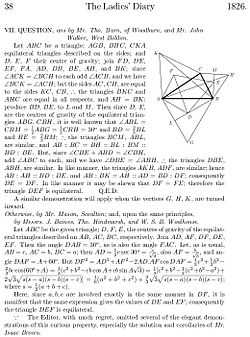Napoleon's theorem

In mathematics, Napoleon's theorem states that if equilateral triangles are constructed on the sides of any triangle, either all outward, or all inward, the centres of those equilateral triangles themselves form an equilateral triangle.
The triangle thus formed is called the Napoleon triangle (inner and outer). The difference in area of these two triangles equals the area of the original triangle.
The theorem is often attributed to Napoleon Bonaparte (1769–1821). However, it may just date back to W. Rutherford's 1825 question published in The Ladies' Diary, four years after the French emperor's death.[1][2]
Proofs
In the figure above, ABC is the original triangle. AZB, BXC, and CYA are equilateral triangles constructed on its sides, and points L, M, and N are the centroids of those triangles. The theorem states that triangle LMN (green) is equilateral.
A quick way to see that the triangle LMN is equilateral is to observe that MN becomes CZ under a clockwise rotation of 30° around A and a homothety of ratio √3 with the same center, and that LN also becomes CZ after a counterclockwise rotation of 30° around B and a homothety of ratio √3 with the same center. The respective spiral similarities[3] are A(√3,-30°) and B(√3,30°). That implies MN = LN and the angle between them must be 60°.[4]
Analytically, it can be determined[5] that each of the three segments of the LMN triangle has a length of:
There are in fact many proofs of the theorem's statement, including a trigonometric one,[5] a symmetry-based approach,[6] and proofs using complex numbers.[5]
Background

The theorem has frequently been attributed to Napoléon but several papers have been written concerning this issue[7][8] which cast doubt upon this assertion (see (Grünbaum 2012)).
The following entry appeared on page 47 in the Ladies' Diary of 1825. This is the earliest known reference to Napoléon's theorem, and it is to be noted that that name does not appear here.
- VII. Quest.(1439); by Mr. W. Rutherford, Woodburn.
- "Describe equilateral triangles (the vertices being either all outward or all inward) upon the three sides of any triangle ABC: then the lines which join the centres of gravity of those three equilateral triangles will constitute an equilateral triangle. Required a demonstration."
Since William Rutherford was a very capable mathematician, his motive for requesting a proof of a theorem that he could certainly have proved himself is unknown. Maybe he posed the question as a challenge to his peers, or perhaps he hoped that the responses would yield a more elegant solution.
Plainly there is no reference to Napoléon in either the question or the published responses, which appeared a year later in 1826, though the Editor evidently omitted some submissions. Also Rutherford himself does not appear amongst the named solvers. The first known reference to this result as Napoléon's theorem appears in Faifofer's 17th Edition of Elementi di Geometria published in 1911.[9]
See also
Notes
- ↑ Grünbaum 2012
- ↑ "Napoleon's Theorem - from Wolfram MathWorld". Mathworld.wolfram.com. 2013-08-29. Retrieved 2013-09-06.
- ↑ Weisstein, Eric W., "Spiral Similarity", MathWorld.
- ↑ For a visual demonstration see Napoleon's Theorem via Two Rotations at Cut-the-Knot.
- ↑ 5.0 5.1 5.2 "Napoleon's Theorem" at MathPages.com.
- ↑ Alexander Bogomolny. "Proof #2 (an argument by symmetrization)". Cut-the-knot.org. Retrieved 2013-09-06.
- ↑ Cavallaro, V.G. (1949), "Per la storia dei teoremi attribuiti a Napoleone Buonaparte e a Frank Morley", Archimede 1: 286–287
- ↑ Scriba, Christoph J (1981). "Wie kommt 'Napoleons Satz' zu seinem namen?". Historia Mathematica 8 (4): 458–459. doi:10.1016/0315-0860(81)90054-9.
- ↑ Faifofer (1911), Elementi di Geometria (17th ed.), Venezia, p. 186, but the historical record cites various editions in different years. This reference is from (Wetzel 1992).
References
- Grünbaum, Branko (2012), "Is Napoleon's Theorem Really Napoleon's Theorem?", American Mathematical Monthly 119 (6): 495–501
- Wetzel, John E. (April 1992). "Converses of Napoleon's Theorem". The American Mathematical Monthly 99 (4): 339–351.
External links
| Wikimedia Commons has media related to Napoleon's theorem. |
- Napoleon's Theorem and Generalizations, at Cut-the-Knot
- To see the construction, at instrumenpoche
- Napoleon's Theorem by Jay Warendorff, The Wolfram Demonstrations Project.
- Weisstein, Eric W., "Napoleon's Theorem", MathWorld.
- Napoleon's Theorem and some generalizations, variations & converses at Dynamic Geometry Sketches
- Napoleon's Theorem, Two Simple Proofs
- Infinite Regular Hexagon Sequences on a Triangle (generalization of Napoleon's Theorem) by Alvy Ray Smith.
This article incorporates material from Napoleon's theorem on PlanetMath, which is licensed under the Creative Commons Attribution/Share-Alike License.
